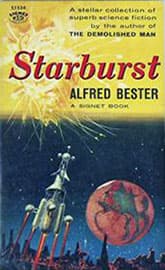Fondly Fahrenheit
Critique • Quotes
 Story collection first edition, 1958
Story collection first edition, 1958First publication
1954 in The Magazine of Fantasy and Science Fiction
First book publication
1958 in Starburst collection
Literature form
Story
Genre
Literary
Writing language
English
Author's country
United States
Length
Approx. 8,000 words
A science fiction tale of the macabre
Alfred Bester's "Fondly Fahrenheit" was chosen by the Science Fiction Writers of America as one of the thirty greatest scifi stories from the pre-1965 era—and published in the now-classic Science Fiction Hall of Fame (1970).
It didn't come near the top of the list in voting. (At the top, by the way, was Isaac Asimov's "Nightfall".) Bester's short work was not even in the first fifteen.
But in its placement near the end of the published volume, "Fondly Fahrenheit" is a pivotal entry. For, much as Bester's novels do for the SF long form, his story forms a bridge from the Golden Age past to the modernist era for the short story form. It heralds the move from hard-science science fiction to the more psychologically sophisticated writing of the period to follow.
The story itself falls into the established subgenre of androids—specifically of androids gone bad. Or turned murderous, as in this case. And it's written in the breathless pulp style, with fast action, snappy dialogue and, frankly, some corny exposition. ("Three distinct shots sounded less than a hundred feet from the fugitives. Blam! Blam! Blam!")
Who said that?
But the story is narrated by...well, it's hard to tell at any particular point who is narrating, for the killer android's playboy owner, James Vandaleur, has been absorbed into the machine's personality. Or is it the other way around? Or both? In any case, the first person keeps jumping back and forth between the two, or encompassing the two.
It's to the credit of Bester's writing talent that this is not as confusing as it may sound. At every point, even when point of view shifts several times within a sentence, readers knows where they are. It's wrenching, particularly near the end when one of the merged personalities is dying, but it is also exhilarating.
I've seen references to "Fondly Fahrenheit" as a horror, rather than scifi, story and I can see that. Apart from the presence of the SF-staple android and the element of inter-planetary travel, it reads like an Edgar Allen Poe tale of psychological terror, updated to more recent slasher thrillers.
Vandaleur lives off the income his multipurpose android can bring in but, everywhere the duo live for a while, dead bodies show up. The story opens on a hot, wet planet with the discovery of a dead child girl with android blood under her fingernails. The pair flee and on the next planet, a ghastly new way of killing a rich lady is found, involving great heat and molten gold. (Did Ian Fleming read this before writing Goldfinger?) They run away again and the pattern is repeated, with a few twists. And so on, until the inevitable end of the twosome. And then a final shock.
The story's title comes from the regular temperature reports given after every murder, as in "the thermometer that day registered 91.9—gloriously Fahrenheit".
Bester, who wrote for print only as a sideline, adapted the story for the television anthology series Sunday Showcase. It appeared as "Murder and the Android" in 1959, starring Kevin McCarthy as James "Valentine" and Rip Torn as the android. The presentation was nominated for the other prestigious science fiction award, the Hugo.
— Eric
Critique • Quotes

